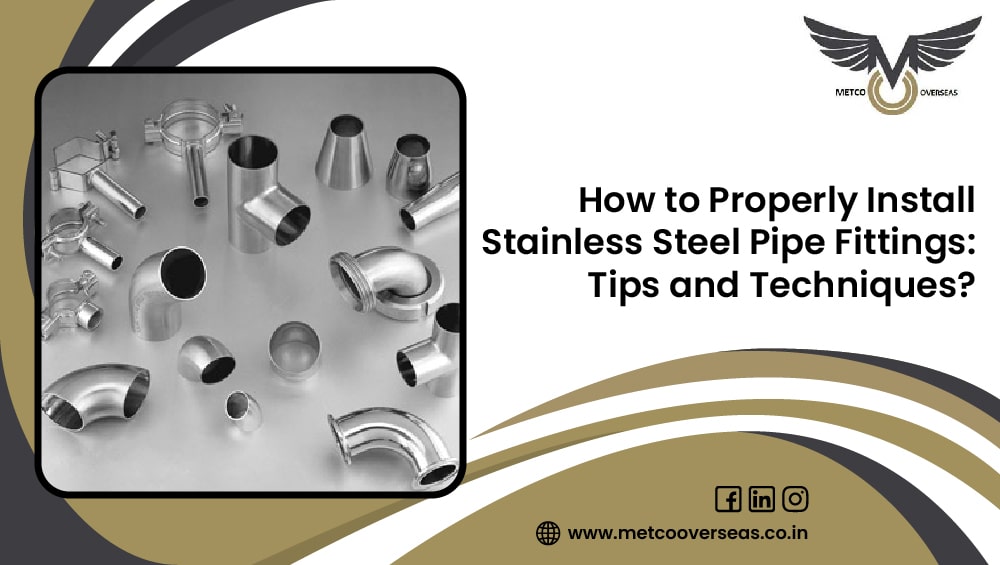Stainless steel pipe fittings are significantly utilized in numerous industries, from plumbing and creation to chemical processing and food manufacturing. Proper installation is important to ensure the efficiency and toughness of those fittings. Whether you’re a pro expert or a newbie in the subject, understanding the right strategies and guidelines can prevent time, prevent leaks, and ensure the safety of your initiatives. In this blog, we are going to discover a way to install stainless steel pipe fittings, percent valuable suggestions, and description techniques to make the way smoother and more.
Understanding Stainless Steel Pipe Fittings
Before diving into the techniques of stainless steel pipe fitting setup, it’s far essential to recognize what those fittings are and why they will be so usually used. Stainless steel pipe fittings are used to connect, redirect, or close to off-pipe structures. The key reason they may be favored is their sturdiness, corrosion resistance, and functionality to face up to excessive temperatures and strain. These characteristics make them perfect for programs in industries inclusive of oil and gasoline, chemical processing, food and beverage, and more.
Now that you realize why stainless steel fittings are used, permits pass on to how to deploy stainless steel pipe fittings well to make certain their normal overall performance is maximum suitable.
Step-with the aid of Step Guide: How to Install Stainless Steel Pipe Fittings
- Choose the Right Type of Fittings
The first step in how to set up stainless steel pipe fittings is choosing the proper form of fitting. There are diverse sorts of stainless steel pipe fittings, together with elbows, tees, reducers, couplings, and flanges. Each serves a specific cause. For example, elbows are used to exchange the path of the piping, while reducers decrease the pipe length. Choosing the proper form of fitting is critical to ensuring a seamless and steady connection.
When selecting a becoming, recollect factors that include the temperature, stress, and surroundings of your software. Ensure the cloth grade of the stainless steel suits the working conditions. Metco Overseas, a main provider of flanges, can provide professional recommendations on the most suitable flanges and fittings for your commercial wishes.
- Prepare the Pipe and Fitting
Proper education of the pipe and fitting is essential earlier than set up. Start by cleansing the pipe ends and the inner surface of the correct to put off any debris, oil, or moisture. Any contamination can lead to wrong sealing and potential leaks.
Use a degreaser or alcohol-based solution to clean the surfaces very well. It’s also an excellent idea to check for any seen defects like cracks, dents, or deformities. Ensuring both the pipe and becoming clean and free from harm is a key tip in a way to install stainless steel pipe fittings effectively.
- Measure and Cut the Pipe
Once the pipe is clean, degree and mark the factor wherein you need to cut the pipe. Precision is key while installing stainless-steel pipe fittings, as any inaccuracies in cutting can result in misalignment and leaks. Use a pipe cutter or a hacksaw to cut the pipe. After reducing, deburr the edges of the pipe to remove any sharp fragments or uneven edges.
Ensuring the pipe is cut to the appropriate length and is easy to round the edges is a critical method of stainless steel pipe fitting installation. This ensures a comfortable shape while connecting the pipe to the proper.
- Apply thread sealant or Teflon tape.
One of the most vital recommendations for stainless steel pipe fitting installation is the usage of a thread sealant or Teflon tape. This prevents leaks on the threaded connections. Wrap the Teflon tape across the male threads of the pipe in a clockwise path. Be careful now not to overwrap, as too much tape can cause mistaken sealing.
Thread sealants or tapes fill in the gaps between the threads, ensuring a good seal and preventing leakage. This step is especially important when running with threaded fittings, which are common in many pipe systems.
- Tighten the fittings.
Once the Teflon tape is applied, you may screw the proper onto the pipe. Start using hand-tightening the correct to ensure it’s aligned properly. Use a wrench to tighten the precise in addition, however, keep away from overtightening. Stainless steel is durable, but immoderate pressure can harm the threads, leading to leakage or breakage.
A crucial approach to stainless-steel pipe fitting installation is finding the proper stability between tightness and torque. The fitting ought to be tight enough to save you from leaks, but not so tight that it damages the threads.
- Test the connection.
After putting in the fitting, it’s vital to test the connection to ensure it’s leak-proof. One way to do that is by taking a stress test. Gradually boom the stress within the gadget and test for any signs and symptoms of leakage at the connection points.
If you stumble on any leaks, tighten the fittings slightly and re-test. If the leak persists, it may be essential to disassemble the connection, reapply thread sealant, and re-tighten it. Ensuring a leak-loose connection is the final step in a way to set up stainless-steel pipe fittings efficiently.
Additional Tips for Stainless Steel Pipe Fittings Installing
Use the Right Tools: Always use the right tools for reducing, threading, and tightening the fittings. Using mistaken gear can harm the fittings and compromise the integrity of the relationship.
Check for Proper Alignment: Misaligned pipes and fittings can cause pressure on the system, leading to leaks or maybe failure. Always test the alignment earlier than tightening the connections.
Avoid Contamination: Stainless metal is pretty immune to corrosion, but contamination with other metals or debris can cause rust or corrosion over the years. Keep your painting’s location smooth and ensure that no other materials come into contact with the stainless steel.
Conclusion
Installing stainless steel pipe fittings requires precision, the proper techniques, and attention to detail. By following the stairs outlined above and applying the recommendations for stainless steel pipe fitting installation, you may make sure of a steady and green piping system. Whether you’re installing fittings in a residential plumbing system or a complex commercial utility, taking the time to do it properly will prevent future complications.
Metco Overseas, a main supplier of flanges and fittings, gives notable products that are best for business use. With their expert guidance and reliable substances, you could be certain of the quality effects on your tasks. Choosing the right fittings and putting them in the well is essential for long-lasting overall performance and safety on your piping structures.
For all your flange and fitting wishes, agree with Metco Overseas to offer long-lasting, incredible products and expert recommendations on how to deploy stainless steel pipe fittings.

